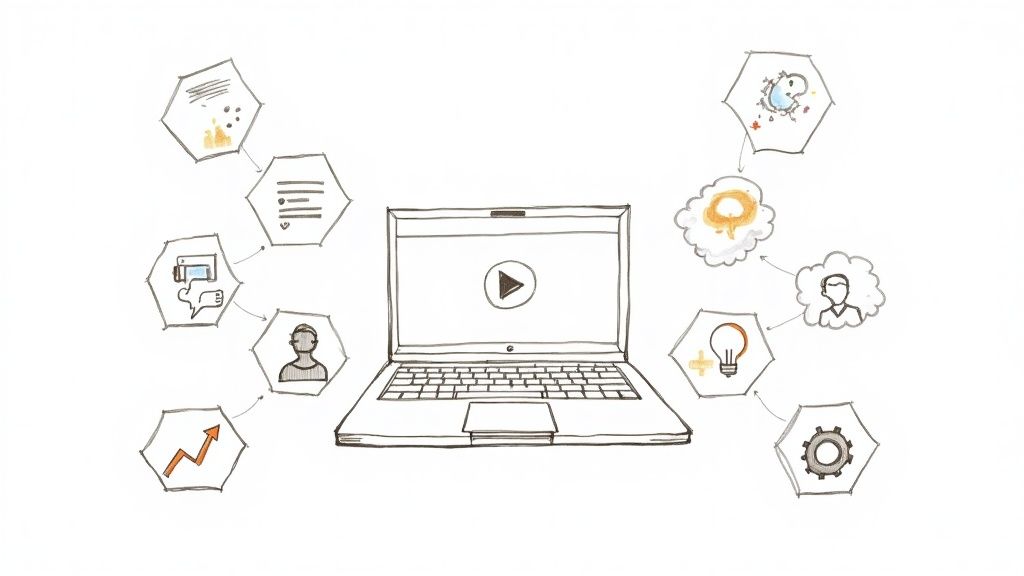
9 Online Learning Best Practices for 2025
The landscape of education and corporate training has permanently shifted, with online learning moving from a niche alternative to a core component of development. Simply moving content online is no longer sufficient. The challenge lies in creating digital experiences that are not just informative but truly transformative, engaging, and effective. The key is to move beyond passive video lectures and static PDFs and embrace dynamic, learner-centric strategies.
This guide delves into a curated set of proven online learning best practices, offering a comprehensive roundup of actionable techniques. We will explore how to design learning that sticks, from fostering active participation to chunking content for better retention and leveraging technology for personalized paths. Whether you are a corporate trainer, instructional designer, or marketing professional, these strategies will equip you to build courses that captivate learners and deliver measurable results.
You will gain specific, immediately applicable insights into:
- Active Learning Techniques: Move learners from passive observers to active participants.
- Content Strategy: Implement microlearning and multimodal delivery for maximum impact.
- Engagement and Community: Use gamification and social learning to build a vibrant learning environment.
- Personalization and Accessibility: Create tailored learning paths that work for everyone, on any device.
We will bypass generic advice to provide you with a tactical playbook. Each point is designed to be a clear, actionable step you can take to enhance your digital education programs. Let's explore the methods that define successful online learning.
1. Master Active Learning to Drive Participation
The cornerstone of effective online education is shifting learners from passive observers to active participants. This approach, known as active learning, is one of the most crucial online learning best practices because it directly combats the passivity often associated with digital environments. Instead of simply consuming content like watching a lecture or reading a PDF, learners are required to do something with the information.
Active learning transforms the digital classroom into an interactive space where students engage directly with the material through problem-solving, discussion, and application. This constant interaction is vital for deepening comprehension and developing critical thinking skills. It’s the difference between reading a recipe and actually cooking the meal; the hands-on experience solidifies the learning and makes it stick.
How to Implement Active Learning
To effectively integrate active learning, focus on creating opportunities for learners to apply knowledge as they acquire it. This requires a deliberate and strategic approach to course design.
- Think-Pair-Share: Pose a thought-provoking question related to the content. Give learners a minute to think individually, then place them in breakout rooms to discuss their thoughts with a partner. Finally, bring the group back together to share key insights. This structure encourages individual reflection, collaborative exploration, and group synthesis.
- Interactive Case Studies: Present a real-world scenario or problem. Instead of providing the solution, ask learners to analyze the situation, identify key issues, and propose their own solutions in a shared document or forum. This is particularly effective for corporate training, where employees can tackle problems relevant to their roles.
- Live Polling and Quizzes: Use integrated tools within your learning platform or video player to insert low-stakes polls and quizzes. Ask questions that require learners to recall information or apply a concept you just explained. This breaks up lectures and provides immediate feedback to both the learner and the instructor.
By embedding these activities directly into your lessons, you create a dynamic learning journey. This proactive engagement not only boosts knowledge retention but also makes the entire educational experience more enjoyable and memorable, ensuring your content has a lasting impact.
2. Microlearning and Chunking Content
In our fast-paced world, attention spans are short and time is a precious commodity. This is where microlearning shines as one of the most effective online learning best practices. This approach involves breaking down complex subjects into small, focused, and easily digestible segments. Instead of a single hour-long lecture, content is “chunked” into a series of 5- to 10-minute modules, each targeting a single learning objective.

This method directly addresses the limitations of working memory and cognitive load theory. By presenting information in bite-sized pieces, you prevent learners from becoming overwhelmed and significantly improve their ability to absorb and retain knowledge. It’s the difference between trying to drink from a firehose and taking small, refreshing sips; the latter is far more manageable and effective. Platforms like Duolingo, with its quick language lessons, and TED-Ed, with its short, animated educational videos, have perfected this model for a modern audience.
How to Implement Microlearning and Chunking
Adopting a microlearning strategy requires a shift in how you structure and present information. The goal is to create a focused, self-contained learning experience in every module. For a deeper dive, you can explore various microlearning strategies on mindstamp.com to enhance your approach.
- One Objective, One Module: Design each micro-lesson to teach a single, specific concept or skill. For example, instead of a lesson on "Advanced Excel Formulas," create separate modules for "Using VLOOKUP," "Mastering PivotTables," and "Creating Conditional Formatting Rules."
- Design for Mobile-First Access: Learners often consume micro-content on the go. Ensure your videos, quizzes, and text are optimized for mobile devices, with clear, large fonts and vertically oriented video where appropriate. This flexibility allows them to learn whenever they have a spare moment.
- Create a Logical Learning Path: While each chunk is self-contained, they should connect to form a cohesive whole. Arrange your modules in a logical sequence so learners can easily progress from one topic to the next, building their knowledge incrementally and seeing the bigger picture emerge.
By chunking your content, you make learning more accessible, less intimidating, and better suited for the needs of today's busy professionals and students. This practice not only boosts engagement but also empowers learners to take control of their educational journey, one manageable step at a time.
3. Embrace Multimodal Content Delivery to Boost Engagement
Catering to diverse learning preferences is essential for creating an inclusive and effective digital classroom. This is where multimodal content delivery shines as a fundamental online learning best practice. The approach involves presenting information through various formats, such as video, audio, text, and interactive graphics, to appeal to visual, auditory, and kinesthetic learners simultaneously. Instead of relying on a single medium, this strategy creates a richer, more dynamic learning environment.
A multimodal approach recognizes that no single format works for everyone. By offering content in different ways, you empower learners to engage with the material on their own terms. For example, a student might watch a video lecture to grasp a concept, review a transcript to solidify key terms, and then complete an interactive simulation to apply their knowledge. This layered experience reinforces learning and significantly improves retention.

How to Implement Multimodal Content Delivery
Successfully integrating multiple content types requires thoughtful planning to ensure each element serves a clear educational purpose without overwhelming the learner. The goal is to create a cohesive experience, not just a collection of different files.
- Align Media with Objectives: Choose your format based on the learning goal. Use short, animated videos to explain complex processes, interactive infographics for data visualization, and podcasts or audio clips for expert interviews. For instance, platforms like Coursera effectively combine video lectures with supplemental readings and hands-on programming assignments.
- Prioritize Accessibility and Consistency: Ensure your learning experience is accessible to all. Provide transcripts for all audio and video content and add alt-text for images. Maintain a consistent design and navigation system across all formats so learners can easily move between a video, a PDF, and a quiz without confusion.
- Balance and Blend Formats: Avoid "multimedia for multimedia's sake." A well-designed module might introduce a topic with a short video, provide an in-depth reading, and then use a low-stakes quiz or a drag-and-drop activity to check for understanding. This prevents cognitive overload while reinforcing the material through different channels.
By adopting a multimodal strategy, you make your content more engaging, accessible, and effective. This approach respects individual learning differences and leverages the full potential of digital media to create memorable educational experiences that resonate with a wider audience.
4. Implement Regular Assessment and Feedback
A critical pillar supporting learner success in a digital setting is the continuous loop of assessment and feedback. This strategy is one of the most impactful online learning best practices because it provides a clear, ongoing picture of a learner’s progress. Instead of relying solely on a final exam, this approach integrates frequent, low-stakes evaluations to identify knowledge gaps and reinforce concepts in real time.
This practice transforms learning from a one-way street into a dynamic dialogue. Regular checkpoints keep learners engaged and motivated, showing them exactly where they stand and what they need to improve. It also provides invaluable data to instructors, allowing them to adjust their teaching strategies to better meet student needs. The goal is to make assessment a tool for learning, not just a measure of it.

How to Implement Regular Assessment and Feedback
Integrating effective assessment requires a blend of well-designed evaluations and timely, constructive guidance. To ensure timely and accurate feedback on learner progress, it's essential to implement regular assessments. Explore various online French level tests to see how instant, automated feedback can guide learners effectively.
- Use a Mix of Assessment Types: Combine formative assessments (like weekly quizzes or reflection journals) to monitor learning with summative assessments (like final projects or exams) to evaluate overall mastery. This provides a balanced view of student performance. For instance, platforms like Codecademy provide instant feedback on coding exercises, a powerful formative tool.
- Provide Timely and Specific Feedback: Aim to deliver feedback within 24-48 hours to keep it relevant and actionable. Use detailed rubrics for subjective assignments to ensure clarity and consistency. Tools like Canvas LMS's SpeedGrader are designed to streamline this process, making it easier to provide high-quality comments quickly.
- Encourage Self-Assessment: Prompt learners to reflect on their own work before submitting it. Ask them to identify their strengths and areas for improvement using a checklist or a simple reflection prompt. This builds metacognitive skills and encourages them to take ownership of their learning journey.
By creating a robust framework for assessment and feedback, you foster a supportive and transparent learning environment. This not only helps students master the material but also builds their confidence and resilience as learners.
5. Strike a Strategic Synchronous and Asynchronous Balance
One of the most powerful online learning best practices is to deliberately blend synchronous (real-time) and asynchronous (self-paced) activities. This hybrid approach harnesses the distinct benefits of both formats, creating a flexible yet connected learning environment. Synchronous learning fosters immediate interaction and community, while asynchronous learning provides the flexibility needed to accommodate diverse schedules, learning paces, and time zones.
Finding the right equilibrium is key. A purely synchronous model can exclude learners with conflicting commitments, while a fully asynchronous one can feel isolating. By combining live sessions with self-directed materials, you create a robust structure that supports deep learning. This approach allows learners to absorb foundational knowledge at their own pace and then use valuable real-time interactions for collaboration, clarification, and application.
How to Implement a Balanced Approach
Integrating both modalities requires careful planning to ensure they complement each other, rather than compete. The goal is to make each component serve a specific, valuable purpose within the overall learning journey.
- Design for Intentionality: Use synchronous time for high-value, interactive activities that benefit most from real-time collaboration, such as complex problem-solving, group project kick-offs, or expert Q&A sessions. Reserve asynchronous activities for content delivery, individual reflection, and foundational skill practice.
- Bridge the Two Modes: Create clear connections between your synchronous and asynchronous elements. For example, assign a short reading or video (asynchronous) and require learners to come to the live session (synchronous) prepared to discuss specific questions. This ensures learners engage with the material beforehand and makes the live session more productive.
- Leverage Asynchronous Tools for Assessment: Use asynchronous tools for more than just content consumption. For a deeper dive into practical asynchronous tools, explore this comprehensive guide to one-way video interviews, which offers valuable insights applicable to self-paced learning modules where learners can record responses to prompts. This method allows for thoughtful, detailed answers without the pressure of a live setting.
By thoughtfully balancing these two powerful delivery methods, you can build a more inclusive, effective, and engaging online learning experience that caters to the modern learner’s needs for both flexibility and connection.
6. Prioritize Mobile-First Design and Accessibility
In an era where learning happens anywhere, from a morning commute to a coffee shop, designing for the smallest screen first is no longer optional. A mobile-first approach ensures your educational content is not just viewable but fully functional and engaging on smartphones and tablets. This strategy is one of the most vital online learning best practices as it addresses the modern learner's reality and simultaneously builds a foundation for universal accessibility.
This approach involves designing the learning experience for mobile devices first, then scaling it up for larger screens like desktops. This forces a focus on core content and streamlined navigation, resulting in a cleaner, more intuitive interface for everyone. By pairing this with a commitment to accessibility standards, you create a truly inclusive environment where every learner, regardless of their device or ability, has an equal opportunity to succeed.
How to Implement Mobile-First and Accessible Design
Integrating this dual focus requires a shift in the design and development process, prioritizing flexibility and inclusivity from the very beginning.
- Responsive and Touch-Friendly Layouts: Design your course interface with large, easily tappable buttons and clear navigation menus. Use a responsive framework that automatically adjusts layouts, text sizes, and images to fit any screen, from a small smartphone to a large monitor. Test your content rigorously on multiple physical devices, not just browser emulators.
- Adhere to WCAG Standards: Follow the Web Content Accessibility Guidelines (WCAG) to make your content accessible to users with disabilities. This includes providing descriptive alt text for all images, ensuring sufficient color contrast between text and backgrounds, and making all content navigable via keyboard-only commands.
- Enable Offline Access: Many learners rely on mobile devices in areas with intermittent internet connectivity. Platforms like the Khan Academy app excel by allowing users to download videos and course materials for offline use. This feature provides flexibility and ensures learning can continue without interruption.
By adopting a mobile-first and accessible design philosophy, you cater to the habits of today's learners and remove barriers to education. This not only expands your audience but also signals a commitment to creating an equitable and effective learning experience for all.
7. Gamify the Experience to Boost Motivation
Leveraging gamification is one of the most powerful online learning best practices for transforming learner motivation and engagement. This strategy involves applying game-design elements like points, badges, and leaderboards to educational content. It taps into our natural human desires for competition, achievement, and reward, making the learning process feel less like a chore and more like an exciting challenge.
Gamification works by providing a clear sense of progression and immediate feedback, which can be highly motivating in a self-paced digital environment. When learners see a progress bar inching forward or earn a badge for mastering a difficult concept, they receive tangible proof of their efforts. This makes abstract learning goals concrete and encourages persistence, ultimately boosting course completion rates and knowledge retention.
How to Implement Gamification
To successfully gamify your online course, you must align game mechanics with your core learning objectives. The goal is not just to entertain but to use fun as a vehicle for deeper understanding and skill development.
- Introduce Points and Badges: Award points for completing modules, participating in discussions, or scoring well on quizzes. Create a system of digital badges that signify mastery of specific skills. For example, a badge like "Data Analysis Expert" is more meaningful than "Completed Module 4" because it represents a real-world capability.
- Create Challenges and Quests: Frame learning activities as challenges or quests. Instead of a standard assignment, present learners with a mission to solve a specific problem using the skills they’ve just acquired. This storytelling approach makes tasks more engaging and contextualizes the knowledge.
- Utilize Leaderboards and Progress Bars: Implement leaderboards to foster friendly competition, but consider making them optional to avoid discouraging learners who prefer not to compete. Visual progress bars are universally effective, as they clearly show learners how far they’ve come and what’s left to complete, providing a strong incentive to reach the finish line.
By thoughtfully integrating these game-like elements, you create a rewarding and interactive journey. This approach not only makes learning more enjoyable but also provides powerful intrinsic and extrinsic motivators that drive learners toward mastery.
8. Implement Personalized Learning Paths
Moving beyond a one-size-fits-all model, personalized learning paths tailor the educational journey to each individual's needs, pace, and performance. This approach is a transformative online learning best practices because it uses data and adaptive technology to create a unique route through the course material for every learner. Instead of forcing everyone down the same linear path, personalization ensures students receive the right content and support at the right time.
This customization makes learning more efficient and effective. A learner who quickly masters a concept can move ahead, while another who struggles can receive additional resources or alternative explanations. This responsiveness not only prevents boredom and frustration but also fosters a sense of ownership over the learning process, significantly boosting motivation and comprehension. It acknowledges that true learning isn't uniform; it's a dynamic, individual experience.
How to Implement Personalized Learning Paths
Creating personalized journeys requires a strategic blend of content modularity and technology. The goal is to build a flexible framework that can adapt to learner inputs and performance data.
- Start with Simple Branching: Before investing in complex adaptive systems, design courses with simple branching scenarios. Based on quiz results or self-assessments, direct learners to different modules. For example, a correct answer might lead to an advanced topic, while an incorrect one leads to a review module.
- Leverage Learning Analytics: Use your platform’s analytics to identify common sticking points and successful learning routes. This data provides invaluable insights into where learners typically struggle or excel, helping you refine and create more effective paths based on real user behavior.
- Offer Learner Choice: Empower students by providing options. Allow them to choose between different content formats (e.g., video, text, case study) or select topics based on their interests and career goals. This autonomy is a powerful motivator and ensures the content remains relevant. Learn more about how to design and implement personalized learning paths on mindstamp.com.
By integrating these strategies, you can shift from a static curriculum to a dynamic, responsive ecosystem. This not only accommodates diverse learning styles but also ensures that every student has the optimal support needed to achieve mastery.
9. Cultivate Community with Social Learning
Humans are inherently social beings, and learning is no exception. Tapping into this instinct through social learning is one of the most powerful online learning best practices for combating the isolation that can undermine digital education. This approach moves beyond the one-to-many instructional model and creates a vibrant ecosystem where learners interact, collaborate, and co-create knowledge. It’s built on the principle that we learn as much from our peers as we do from a formal instructor.
By fostering a strong sense of community, you transform a simple course into a supportive and dynamic environment. Learners are more motivated to participate when they feel connected to others, leading to richer discussions, deeper understanding, and enhanced problem-solving skills. Platforms like Coursera, with its robust discussion forums and peer-graded assignments, demonstrate how building a community directly enhances the educational journey and improves outcomes.
How to Implement Social Learning
Integrating social learning requires intentionally designing spaces and activities that encourage peer-to-peer connection. The goal is to make interaction a core component of the learning process, not an afterthought.
- Establish a Dedicated Community Hub: Create a central space for interaction outside of formal lessons, such as a dedicated Discord server, a private subreddit, or a Slack channel. Post welcome threads, establish clear community guidelines, and use it as a place for informal Q&A and knowledge sharing.
- Facilitate Structured Peer Feedback: Implement activities where learners review and provide constructive feedback on each other's work. Provide clear rubrics and sentence starters to guide the feedback process, ensuring it remains positive and helpful. This not only improves the quality of work but also teaches valuable collaboration skills.
- Organize Group Projects and Challenges: Design assignments that require learners to work together in small groups to solve a complex problem or create a deliverable. This is highly effective in corporate training, where teams can tackle challenges directly relevant to their work, mirroring real-world collaborative scenarios.
By weaving these social elements into your course design, you create an engaging and self-sustaining learning environment. This community-driven approach not only boosts retention and completion rates but also builds a lasting network that learners can rely on long after the course is finished.
Best Practices Comparison of 9 Online Learning Strategies
From Theory to Practice: Implementing Your Online Learning Strategy
We've explored a comprehensive landscape of nine distinct yet interconnected online learning best practices. From the tactical precision of microlearning and the dynamic engagement of gamification to the foundational importance of mobile-first design and personalized learning paths, each strategy offers a powerful lever for transforming passive content consumption into active, meaningful learning. The journey through these concepts has illuminated a central truth: exceptional online learning is not a happy accident. It is the result of intentional design, strategic implementation, and a deep commitment to the learner's experience.
Moving forward, the challenge is to translate these powerful ideas from the theoretical page into your practical, day-to-day workflow. This transition from knowing to doing is where real impact is made, where learner comprehension deepens, engagement soars, and your educational goals are not just met but exceeded.
Synthesizing the Core Principles
As you reflect on the strategies discussed, several core themes emerge. These are the foundational pillars that support all effective online learning initiatives.
- Learner-Centricity: Every practice, from active learning exercises to personalized paths, places the learner at the core of the experience. It’s a fundamental shift from "What do I need to teach?" to "How will my audience best learn and apply this knowledge?"
- Engagement Through Interaction: Passive video lectures and static documents are no longer sufficient. The modern learner thrives on interaction, whether through gamified leaderboards, collaborative social forums, or direct engagement within a video.
- Flexibility and Accessibility: Recognizing that learners have diverse needs, schedules, and devices is non-negotiable. A successful strategy thoughtfully balances synchronous and asynchronous elements and ensures content is accessible to everyone, everywhere, on any device.
- Data-Informed Iteration: The most effective learning programs are living entities. By implementing regular, low-stakes assessments and gathering feedback, you create a continuous improvement loop, allowing you to refine your content based on real learner data and behavior.
Your Actionable Roadmap to Implementation
The sheer volume of possibilities can feel overwhelming, but progress is about momentum, not immediate perfection. You don't need to revolutionize your entire learning ecosystem overnight. The key is to start small, build confidence, and scale what works.
Here is a simple, three-step plan to begin applying these online learning best practices today:
- Audit and Identify: Review your existing learning materials against the nine practices we've covered. Where is your biggest opportunity for a quick win? Is it breaking down a lengthy one-hour webinar into five-minute microlearning videos? Could you introduce a discussion forum to foster a sense of community around a key course?
- Select and Experiment: Choose one or two practices that align most directly with your immediate goals. For a sales team, this might be adding interactive questions to product demo videos to qualify leads. For a corporate L&D manager, it could be gamifying a compliance module to boost completion rates.
- Measure and Refine: Implement your chosen strategy on a small scale. Gather both quantitative data (e.g., quiz scores, completion times) and qualitative feedback (e.g., surveys, comments). Use these insights to refine your approach before rolling it out more broadly.
By adopting this iterative methodology, you build a sustainable framework for enhancement. Each small change contributes to a more robust, engaging, and ultimately more effective learning environment. Embracing these principles is more than an operational upgrade; it's a strategic investment in the success and empowerment of your learners, creating experiences that don't just transfer information but truly inspire action and drive results.
Ready to put these online learning best practices into action? Mindstamp makes it simple to transform your standard videos into compelling, interactive experiences with clickable buttons, questions, and personalized pathways. Start building more engaging and effective learning content today by exploring what Mindstamp can do for you.
Get Started Now
Mindstamp is easy to use, incredibly capable, and supported by an amazing team. Join us!



Try Mindstamp Free










